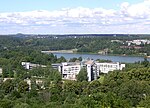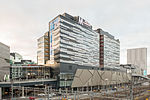European Centre for Disease Prevention and Control
2004 establishments in Sweden2004 in the European UnionAgencies of the European UnionAll pages needing cleanupEuropean medical and health organizations ... and 7 more
Government agencies established in 2004Health and the European UnionNational public health agenciesPublic health organizationsScientific organizations based in SwedenStockholm CountyWikipedia introduction cleanup from August 2020

The European Centre for Disease Prevention and Control (ECDC) is an agency of the European Union (EU) whose mission is to strengthen Europe's defences against infectious diseases. It covers a wide spectrum of activities, such as: surveillance, epidemic intelligence, response, scientific advice, microbiology, preparedness, public health training, international relations, health communication, and the scientific journal Eurosurveillance.The centre was established in 2004 and is headquartered in Solna, Sweden.
Excerpt from the Wikipedia article European Centre for Disease Prevention and Control (License: CC BY-SA 3.0, Authors, Images).European Centre for Disease Prevention and Control
Gustav III:s boulevard, Solna kommun
Geographical coordinates (GPS) Address Phone number Website External links Nearby Places Show on map
Geographical coordinates (GPS)
| Latitude | Longitude |
|---|---|
| N 59.372777777778 ° | E 18.017222222222 ° |
Address
Europeiskt centrum för förebyggande och kontroll av sjukdomar (EU:s smittskyddsmyndighet)
Gustav III:s boulevard 40
169 73 Solna kommun, Frösunda
Sweden
Open on Google Maps









